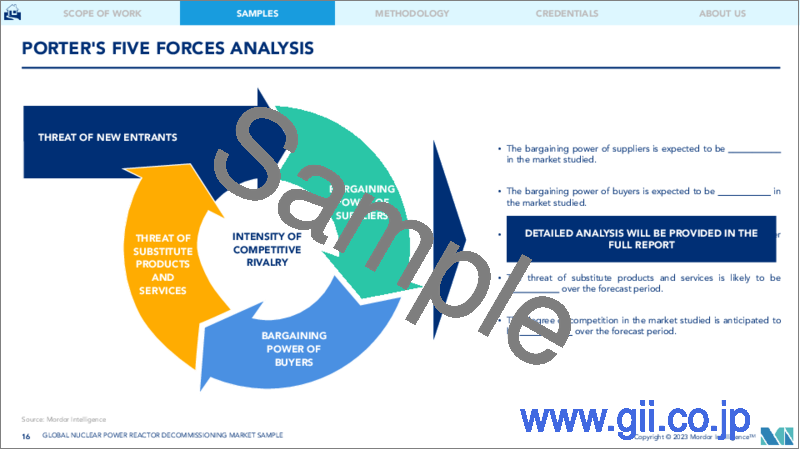|
|
市場調査レポート
商品コード
1197754
原子力発電所の廃止措置市場- 成長、動向、予測(2023年~2028年)Nuclear Power Reactor Decommissioning Market - Growth, Trends, and Forecasts (2023 - 2028) |
||||||
|
● お客様のご希望に応じて、既存データの加工や未掲載情報(例:国別セグメント)の追加などの対応が可能です。 詳細はお問い合わせください。 |
|||||||
| 原子力発電所の廃止措置市場- 成長、動向、予測(2023年~2028年) |
|
出版日: 2023年01月23日
発行: Mordor Intelligence
ページ情報: 英文 125 Pages
納期: 2~3営業日
|
- 全表示
- 概要
- 目次
原子力発電所の廃止措置の世界市場は、本年度末には20億2,749万米ドルに達すると推定され、予測期間中に13.8%のCAGRで推移すると予測されています。
調査対象の市場は、2020年のCOVID-19パンデミックの影響を中程度に受けたもの、回復傾向にあり、パンデミック前の水準に到達しています。
市場成長の主な要因は、運転終了に至る原子炉の増加、再生可能な発電源(風力や太陽光など)の価格低下、環境問題への感度の高まりなどです。
しかし、政府の好意的な政策による原子力発電所の延命が、市場成長の妨げになると予想されます。
ドイツ、英国、韓国など数ヵ国における脱原発政策により、国内外の事業者が廃炉市場の発展に必要な専門知識を提供する機会が生まれると予想されます。
北米は、原子力発電所の廃止措置の市場として最も急速に成長すると予想され、米国はこの地域における重要な廃止措置のホットスポットの1つとなっています。
原子力発電炉の廃止措置の市場動向
商業用原子炉セグメントが市場を独占すると予想される
2022年10月現在、32カ国で437基の商業用原子力発電所が稼働しています。米国は原子力発電の発電能力が最も大きく、原子力発電の発電量も他国より多いです。フランスは原子力発電容量が2位で、原子力発電量も2位です。
商業用原子力発電所の停止と廃炉には、経済的要因、規制的要因、社会的要因など、いくつかの要因が絡んでいます。運転寿命の終了や、太陽光や風力などの代替エネルギー発電のコスト低下など、いくつかの一次要因は、原子力エネルギーのコスト競争力を低下させました。2011年の福島原発事故後、世界中で原子力の安全対策が強化され、インフラのアップグレードや運転・保守コストの増加に伴う追加コストが発生しました。このため、多くの古い商業用原子炉の運転者は、運転寿命が40年で、インフラのアップグレードによりさらに20年延長できる古い原子炉を廃炉にすることを選択しています。
また、世界各国の政府による政策レベルの取り組みも、原子力発電所の閉鎖につながっています。多くの国の政府が、自国のエネルギーミックスの中で原子力を減らすことを計画したのです。こうした規制政策は、再生可能エネルギーが豊富で、商業用原子力発電所の稼働による環境負荷や潜在的なリスクについて深刻な懸念を抱いている西欧の国々で広く見られるものです。
ドイツは、その国家政策に従って、2022年末までにすべての原子炉を停止する計画です。2017年、スイスは国内から原子力発電所を段階的に廃止することを決議しました。2020年9月、ベルギー政府は2025年までに原子力発電を段階的に廃止することを再確認する協定に署名しました。スペインは、稼働中の商業用原子炉7基のうち4基を2030年までに閉鎖し、残りの3基を今後5年以内に閉鎖し、2035年までに原子力発電を完全に廃止すると宣言しました。
再生可能エネルギー技術の開発と経済性の向上により、その大規模な開発が進んでいます。世界中の国々が再生可能エネルギーに関連する巨大なインフラを構築しており、それが原子炉の必要性を相殺しているのです。原子力発電は再生可能エネルギー源に取って代わられつつあり、原子炉の閉鎖につながっています。したがって、再生可能エネルギー源の開発の急増は、世界の原子力発電所の廃止措置市場を大きく後押ししています。
したがって、前述の要因から、予測期間中は商業用原子炉が調査対象市場を独占すると予想されます。
北米が大幅な成長を遂げると予想される
北米は、世界で運転可能な原子炉の数が最大の地域の1つです。原子力発電所の廃止措置市場は、米国、カナダ、メキシコからの需要により、大きな成長を示すことが期待されます。
米国は最大の原子力発電所の1つであり、2021年の世界の原子力発電量の30%を占めています。同国の原子炉による2021年の発電量は778.15TWhで、2020年から1.48%の微減となっています。
2022年8月現在、米国では30の州で合計94.7GWeの容量を持つ92基の原子炉が稼働しており、30の電力会社によって使用されています。また、2基の原子炉が建設中で、合計2.23GWeの原子炉があります。
米国では原子力の時代が終わり、原子力発電所の廃炉が重要な産業になっています。民間会社がこれらの原発を買収し、ライセンス、責任、廃炉資金、廃棄物契約などを引き継いでいるのです。約41基、合計1997万kWの原子炉が停止し、最新のものは2022年5月に停止したミシガン州のパリセーズ原発です。2021年12月、HoltecInternationalは、ミシガン州コバートのパリセーズ原発を取得し、廃炉と解体のための認可を原子力規制委員会から取得しました。2030年までに約198基の原子炉が停止すると予想されます。
米国の原子炉は老朽化が進んでいます。米国原子力規制委員会(NRC)は、後続ライセンス更新(SLR)プログラムにより、運転ライセンスを60年から80年以上延長する申請を検討しています。しかし、最近になって、45~50年での早期引退を選択する発電所オーナーも出てきています。
低コストのシェールガスを利用した発電との激しい競合が、国内の原子力発電産業の競争力を損ねた。記録的な低水準の卸売電力価格と寿命延長(PLEX)アップグレードの高コストが相まって、原子力発電所の早期引退を促しています。
長年にわたり、カナダは原子力研究・技術のリーダーとして、カナダで開発された原子炉システムを輸出してきました。2021年、カナダは原子力発電所から92.6TWhの電力を生み出し、全発電量構成の約15%を占めました。オンタリオ州では、19基の運転可能な原子炉(合計容量13,624MW)と6基程度の原子炉(合計容量214万kW)が2022年8月に停止されました。
2022年8月現在、カナダには使用されなくなり停止された様々な研究用および試作用の発電用原子炉があります。これらの原子炉は安全な保管状態にあり、最終的な廃炉を待っているところです。これらの原子炉には、WR-1、チョークリバー研究所(CRL)のNRX炉、CRLのMAPLE-1およびMAPLE-2(多目的応用物理格子実験)炉、QC州ベカンクールのジェンティリー1原子力発電所、ON州ロルフトンの原子力発電実証(NPD)炉、ON州キンカーディンのダグラスポイント原子力発電所などがあります。これらは、予測期間中、カナダの原子力発電所の廃止措置市場の需要を牽引すると予想されます。
したがって、北米は予測期間中、原子力発電所の廃止措置市場で大きな成長を遂げることが予想されます。
原子力発電所の廃止措置市場の競合他社分析
原子力発電所の原子力発電所の廃止措置市場は適度に断片化されています。市場の主なプレーヤー(順不同)は、Babcock International Group PLC、Fluor Corporation、GE Hitachi Nuclear Services、AECOM、Westinghouse Electric Companyなどです。
その他の特典
- エクセル形式の市場予測(ME)シート
- アナリストによる3ヶ月間のサポート
目次
第1章 イントロダクション
- 調査範囲
- 調査の前提
第2章 エグゼクティブサマリー
第3章 調査手法
第4章 市場の概要
- イントロダクション
- 2027年までの市場規模・需要予測(単位:100万米ドル)
- 原子力発電量予測(TWh)、2027年まで
- 最近の動向と展開
- 市場力学
- 促進要因
- 抑制要因
- サプライチェーン分析
- ポーターのファイブフォース分析
- 供給企業の交渉力
- 消費者の交渉力
- 新規参入業者の脅威
- 代替品の脅威
- 競争企業間の敵対関係
第5章 市場セグメンテーション
- 原子炉タイプ別
- 加圧水型原子炉
- 加圧水型重水炉
- 沸騰水型原子炉
- 高温ガス炉
- 液体金属高速増殖炉
- その他の原子炉
- 用途別
- 商用電源用原子炉
- 発電用試作炉
- 研究用原子炉
- 容量別
- 100MW以下
- 100-1000MW未満
- 1000MW以上
- 地域別で見る
- 北米
- アジア太平洋地域
- 欧州
- 南米
- 中東地域
第6章 競合情勢
- M&A、ジョイントベンチャー、コラボレーション、合意書
- 主要なプレーヤーが採用する戦略
- 企業プロファイル
- Babcock International Group PLC
- James Fisher & Sons PLC
- NorthStar Group Services Inc.
- Fluor Corporation
- GE Hitachi Nuclear Services
- Studsvik AB
- Enercon Services Inc.
- Orano Group
- Aecom
- Bechtel Group Inc.
- Westinghouse Electric Company
第7章 市場機会と将来動向
The global nuclear power reactor decommissioning market is estimated to reach USD 2027.49 million by the end of the current year, and it is projected to register a CAGR of 13.8% during the forecast period.
Although the market studied was moderately impacted by the COVID-19 pandemic in 2020, it has been recovering and reached pre-pandemic levels.
The major factors driving the market's growth are the increasing number of nuclear reactors reaching operational retirement, declining prices of renewable power generation sources (i.e., wind and solar), and growing sensitivity toward environmental issues.
However, the lifetime extension of nuclear power plants with favorable government policies is expected to hinder the market's growth.
Nuclear phase-out policies in several countries, such as Germany, the United Kingdom, and South Korea, are expected to create opportunities for foreign and domestic players to provide the necessary expertise for the country's needs to develop their decommissioning market.
North America is expected to be the fastest-growing market for nuclear power reactor decommissioning, with the United States being one of the significant decommissioning hotspots in the region.
Nuclear Power Reactor Decommissioning Market Trends
Commercial Reactors Segment is Expected to Dominate the Market
As of October 2022, 437 commercial nuclear power plants were in operation across 32 countries. The United States had the largest nuclear electricity generation capacity and generated more nuclear electricity than any other country. France has the second-largest nuclear electricity generation capacity and second-highest nuclear electricity generation.
Several factors are responsible for the shutdown and decommissioning of commercial nuclear power plants, including economic, regulatory, and social factors. Some primary factors, such as the end of operational life and the fall in the cost of alternative energy generation sources, like solar and wind, made nuclear energy less cost-competitive. Following the Fukushima disaster of 2011, nuclear safety protocols have been upgraded across the world, which levied additional costs for the upgradation of infrastructure and increased operations and maintenance costs. Due to this, operators of many older commercial reactors, which have an operating life of 40 years and can be extended by 20 more years with infrastructural upgrades, are opting to decommission older units.
The policy-level initiatives from governments across the world have also led to the shutdown of nuclear power plants. The governments in many countries planned to reduce nuclear power in the energy mix of their countries. Such regulatory policies are prevalent among Western European states with a strong renewable portfolio and serious concerns about the environmental footprint and potential risk of operating commercial nuclear power plants.
As per its national policy, Germany plans to shut down all its reactors by the end of 2022. In 2017, Switzerland voted to phase-out nuclear power plants from the country. In September 2020, the Belgian government signed an agreement reaffirming its commitment to phasing-out nuclear power by 2025. Spain declared that it will close four of its seven operating commercial reactors by 2030 and close the rest three reactors within the next five years, completely phasing out nuclear generation by 2035.
The development of renewable energy technologies and increasing economic viability have led to its massive development. Countries across the world are creating huge infrastructures pertaining to renewable power, which has offset the requirement for nuclear reactors. Nuclear power generation is being replaced by renewable energy sources, which led to the closure of nuclear reactors. Therefore, the surge in the development of renewable energy sources is a big boost for the global nuclear reactor decommissioning market.
Therefore, due to the aforementioned factors, commercial rectors are expected to dominate the market studied during the forecast period.
North America is Expected to Witness Significant Growth
North America is one of the largest regions in terms of operable reactors worldwide. The nuclear power reactor decommissioning market is expected to witness significant growth due to the demand from the United States, Canada, and Mexico.
The United States is one of the largest nuclear power producers, accounting for 30% of the global nuclear power generated in 2021. The country's nuclear reactors produced 778.15 TWh of electricity in 2021, representing a slight decline of 1.48% from 2020.
As of August 2022, the United States has 92 operating nuclear power reactors with a combined capacity of 94.7 GWe in 30 states, used by 30 different power companies. Two reactors are under construction with a total of 2.23 GWe.
As the era of nuclear power winds down in the United States, the decommissioning of nuclear power plants is becoming a significant industry. Private companies are acquiring these plants, taking over their licenses, liability, decommissioning funds, and waste contracts. Around 41 reactors with a combined capacity of 19.97 GW were shut down, the latest being the Palisades nuclear plant in Michigan shut down in May 2022. In December 2021, HoltecInternational received approval from the Nuclear Regulatory Commission to acquire the Palisades plant in Covert, Michigan, to decommission and dismantle the plant. Around 198 reactors are expected to shut down by 2030.
The nuclear reactor fleet of the United States is aging. The United States Nuclear Regulatory Commission (NRC) is considering applications for extending operating licenses beyond 60 to 80 years with its subsequent license renewal (SLR) program. However, some plant owners recently opted for early retirement of their nuclear units at 45 to 50 years old.
Intense competition from electricity generation using low-cost shale gas hurt the competitiveness of the nuclear power industry in the country. Record low wholesale electricity prices and the high cost of life extension (PLEX) upgrades have together driven early nuclear plant retirements.
For many years, Canada has been a leader in nuclear research and technology, exporting reactor systems developed in Canada. In 2021, Canada generated 92.6 TWh of electricity from nuclear power plants, accounting for about 15% of the total electricity generation mix. In Ontario, 19 operable reactors with a combined capacity of 13,624 MW and around six reactors with a combined capacity of 2.14 GW were shut down in August 2022.
As of August 2022, Canada has a variety of research and prototype power reactors that are no longer in use and have been shut down. These reactors are in a safe storage state and awaiting final decommissioning. Some of these reactors include the WR-1, the NRX reactor at Chalk River Laboratories (CRL), the MAPLE-1 and MAPLE-2 (Multipurpose Applied Physics Lattice Experiment) reactors at CRL, the Gentilly-1 nuclear generating station in Becancour, QC, the Nuclear Power Demonstration (NPD) reactor in Rolphton, ON, and the Douglas Point nuclear-generating station in Kincardine, ON. These are expected to drive the demand for the Canadian nuclear power reactor decommissioning market during the forecast period.
Therefore, North America is expected to witness significant growth in the nuclear power reactor decommissioning market during the forecast period.
Nuclear Power Reactor Decommissioning Market Competitor Analysis
The nuclear power reactor decommissioning market is moderately fragmented. Some of the major players in the market (in no particular order) are Babcock International Group PLC, Fluor Corporation, GE Hitachi Nuclear Services, AECOM, and Westinghouse Electric Company.
Additional Benefits:
- The market estimate (ME) sheet in Excel format
- 3 months of analyst support
TABLE OF CONTENTS
1 INTRODUCTION
- 1.1 Scope of Study
- 1.2 Study Assumptions
2 EXECUTIVE SUMMARY
3 RESEARCH METHODOLOGY
4 MARKET OVERVIEW
- 4.1 Introduction
- 4.2 Market Size and Demand Forecast in USD million, till 2027
- 4.3 Nuclear Power Generation Forecast in TWh, till 2027
- 4.4 Recent Trends and Developments
- 4.5 Market Dynamics
- 4.5.1 Drivers
- 4.5.2 Restraints
- 4.6 Supply Chain Analysis
- 4.7 Porter's Five Forces Analysis
- 4.7.1 Bargaining Power of Suppliers
- 4.7.2 Bargaining Power of Consumers
- 4.7.3 Threat of New Entrants
- 4.7.4 Threat of Substitutes Products and Services
- 4.7.5 Intensity of Competitive Rivalry
5 MARKET SEGMENTATION
- 5.1 By Reactor Type
- 5.1.1 Pressurized Water Reactor
- 5.1.2 Pressurized Heavy Water Reactor
- 5.1.3 Boiling Water Reactor
- 5.1.4 High-temperature Gas-cooled Reactor
- 5.1.5 Liquid Metal Fast Breeder Reactor
- 5.1.6 Other Reactor Types
- 5.2 By Application
- 5.2.1 Commercial Power Reactor
- 5.2.2 Prototype Power Reactor
- 5.2.3 Research Reactor
- 5.3 By Capacity
- 5.3.1 Below 100 MW
- 5.3.2 100-1000 MW
- 5.3.3 Above 1000 MW
- 5.4 By Geography
- 5.4.1 North America
- 5.4.2 Asia-Pacific
- 5.4.3 Europe
- 5.4.4 South America
- 5.4.5 Middle East
6 COMPETITIVE LANDSCAPE
- 6.1 Mergers and Acquisitions, Joint Ventures, Collaborations, and Agreements
- 6.2 Strategies Adopted by Leading Players
- 6.3 Company Profiles
- 6.3.1 Babcock International Group PLC
- 6.3.2 James Fisher & Sons PLC
- 6.3.3 NorthStar Group Services Inc.
- 6.3.4 Fluor Corporation
- 6.3.5 GE Hitachi Nuclear Services
- 6.3.6 Studsvik AB
- 6.3.7 Enercon Services Inc.
- 6.3.8 Orano Group
- 6.3.9 Aecom
- 6.3.10 Bechtel Group Inc.
- 6.3.11 Westinghouse Electric Company




